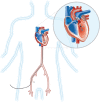The Impella Device: Historical Background, Clinical Applications and Future Directions
- PMID: 31384109
- PMCID: PMC6679960
- DOI: 10.1055/s-0038-1676369
The Impella Device: Historical Background, Clinical Applications and Future Directions
Abstract
The Impella device is a catheter-based miniaturized ventricular assist device. Using a retrograde femoral artery access, it is placed in the left ventricle across the aortic valve. The device pumps blood from left ventricle into ascending aorta and helps to maintain a systemic circulation at an upper rate between 2.5 and 5.0 L/min. This results in almost immediate and sustained unloading of the left ventricle, while increasing overall systemic cardiac output. The most common indications for using the Impella device are in the treatment of acute myocardial infarction complicated by cardiogenic shock and to facilitate high risk coronary angioplasty. Other indications include the treatment of cardiomyopathy with acute decompensation, postcardiotomy shock, and off-pump coronary bypass surgery. A growing body of observational and registry data suggest a potentially valuable role for the Impella system in reducing the mortality associated with cardiogenic shock. However, there are, as of yet, no randomized controlled trial data supporting this observation.
Keywords: Archimedes' screw; Impella device; cardiogenic shock; high risk coronary angioplasty; mechanical circulatory support; postcardiotomy shock; ventricular assist device.
Conflict of interest statement
Figures


References
-
- Kantrowitz A, Tjonneland S, Freed P S, Phillips S J, Butner A N, Sherman J L., Jr Initial clinical experience with intraaortic balloon pumping in cardiogenic shock. JAMA. 1968;203(02):113–118. - PubMed
-
- Weintraub R M, Aroesty J M, Paulin S et al.Medically refractory unstable angina pectoris. I. Long-term follow-up of patients undergoing intraaortic balloon counterpulsation and operation. Am J Cardiol. 1979;43(05):877–882. - PubMed
-
- Bregman D, Casarella W J. Percutaneous intraaortic balloon pumping: initial clinical experience. Ann Thorac Surg. 1980;29(02):153–155. - PubMed
-
- Atkinson T M, Ohman E M, O'Neill W W, Rab T, Cigarroa J E; Interventional Scientific Council of the American College of Cardiology.A practical approach to mechanical circulatory support in patients undergoing percutaneous coronary intervention: an interventional perspective JACC Cardiovasc Interv 2016909871–883. - PubMed
-
- Rihal C S, Naidu S S, Givertz M M et al.2015 SCAI/ACC/HFSA/STS clinical expert consensus statement on the use of percutaneous mechanical circulatory support devices in cardiovascular care: endorsed by the American Heart Assocation, the Cardiological Society of India, and Sociedad Latino Americana de Cardiologia Intervencion; affirmation of value by the Canadian Association of Interventional Cardiology-Association Canadienne de Cardiologie d'intervention. J Am Coll Cardiol. 2015;65(19):e7–e26. - PubMed

